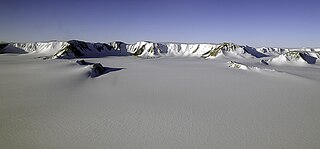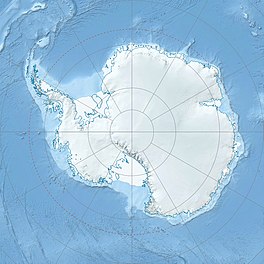
The Shackleton Range is a mountain range in Antarctica that rises to 1,875 metres (6,152 ft) and extends in an east–west direction for about 100 miles (160 km) between the Slessor and Recovery Glaciers.

The Herbert Mountains are a conspicuous group of rock summits on the east side of Gordon Glacier in the Shackleton Range of Antarctica. They were first mapped in 1957 by the Commonwealth Trans-Antarctic Expedition and named for Sir Edwin S. Herbert, Chairman of the Finance Committee and a Member of the Committee of Management of the expedition, 1955–58.
Shaler Cliffs is a rock cliffs 2 miles (3.2 km) east-southeast of Charpentier Pyramid, rising to 1,000 m in the north part of Herbert Mountains, Shackleton Range. Photographed from the air by the U.S. Navy, 1967, and surveyed by British Antarctic Survey (BAS), 1968–71. In association with the names of glacial geologists grouped in this area, named by the United Kingdom Antarctic Place-Names Committee (UK-APC) after Nathaniel S. Shaler (1841-1906), American geologist, joint author with geographer William Morris Davis of Glaciers and of papers on glacial geology, 1884–92.

Shotton Snowfield is a large snowfield between Herbert Mountains and Pioneers Escarpment on the north and Read Mountains on the south, in the Shackleton Range of Antarctica.
Gordon Glacier is an Antarctic glacier of at least 24 nautical miles in length flowing in a northerly direction beginning in the Crossover Pass, flowing through the Shackleton Range to finally meet the Slessor Glacier.
Bernhardi Heights is a line of heights to 1,220 metres (4,000 ft), snow-covered to east but with a west-facing rock escarpment, rising east of Schimper Glacier in the Herbert Mountains, Shackleton Range. They were photographed from the air by the U.S. Navy in 1967, and they were surveyed by the British Antarctic Survey between 1968 and 1971. In association with the names of glacial geologists grouped in this area, they were named by the UK Antarctic Place-Names Committee in 1971 after Reinhard Bernhardi, a German geologist who in 1832 first recognized the moraines and erratics of north Germany as evidence of a former south extension of the Arctic ice sheet.
Blaiklock Glacier is a glacier 16 nautical miles (30 km) long, flowing north from Turnpike Bluff, then northwest to Mount Provender and Mount Lowe in the western part of the Shackleton Range, Antarctica. It was first mapped in 1957 by the Commonwealth Trans-Antarctic Expedition (CTAE), and named for Kenneth V. Blaiklock, the leader of the advance party of the CTAE in 1955–56 and a surveyor with the transpolar party in 1956–58.

Otter Highlands is a group of peaks and ridges extending northwest-southeast for 17 nautical miles from Mount Lowe to Wyeth Heights, located west of Blaiklock Glacier and forming the west end of the Shackleton Range. Surveyed by the Commonwealth Trans-Antarctic Expedition in 1957. Named by the United Kingdom Antarctic Place-Names Committee (UK-APC) in 1972 after the De Havilland Otter aircraft which supported the CTAE.
Warden Pass is a snow pass at about 1,000 m trending east–west between the northwest side of Fuchs Dome and Flat Top in the Shackleton Range. The area was surveyed by Commonwealth Trans-Antarctic Expedition in 1957. Named by the United Kingdom Antarctic Place-Names Committee (UK-APC) after Michael A. Warden, British Antarctic Survey (BAS) general assistant, Halley Station, 1970–72, who worked in the area.
Cornwall Glacier is a glacier 9 nautical miles (17 km) long, flowing south from Crossover Pass in the Shackleton Range to join Recovery Glacier east of Ram Bow Bluff.
The Stratton Glacier is a glacier 20 nautical miles (37 km) long, flowing north from Pointer Nunatak and then northwest to the north of Mount Weston, in the Shackleton Range of Antarctica.
Fuchs Dome is a large ice-covered dome rising over 1,525 metres (5,000 ft), between Stratton Glacier and Gordon Glacier in the central part of the Shackleton Range, Antarctica. It was first mapped in 1957 by the Commonwealth Trans-Antarctic Expedition (CTAE) and named for Sir Vivian E. Fuchs, leader of the CTAE 1955–58.

Pioneers Escarpment is a mostly snow-covered north-facing escarpment, interrupted by occasional bluffs and spurs, between Slessor Glacier on the north and Shotton Snowfield on the south, in the Shackleton Range. The escarpment was photographed from the air by the U.S. Navy, 1967, and was surveyed by British Antarctic Survey (BAS), 1968–71. So named by United Kingdom Antarctic Place-Names Committee (UK-APC) because features on the escarpment are named after the pioneers whose inventions have assisted living and traveling conditions in the polar regions.
Glen Glacier is a glacier at least 7 nautical miles (13 km) long, flowing south in the Shackleton Range of Antarctica to join Recovery Glacier to the west of the Read Mountains.

The Haskard Highlands are a range of peaks and ridges between Blaiklock Glacier and Stratton Glacier in the northwest of the Shackleton Range, Antarctica, rising to 1,210 metres (3,970 ft) at Mount Weston and including features between Mount Provender and Pointer Nunatak. The highlands were first mapped in 1957 by the Commonwealth Trans-Antarctic Expedition, and photographed from the air by the U.S. Navy in 1967. They were surveyed by the British Antarctic Survey between 1968 and 1971, and named by the UK Antarctic Place-Names Committee in 1971 after Sir Cosmo Haskard, Governor of the Falkland Islands 1964–70.
Mount Skidmore is a mountain on the east side of the mouth of Stratton Glacier in the Shackleton Range. It was first mapped in 1957 by the CTAE, and it was photographed in 1967 by U.S. Navy trimetrogon aerial photography. It was named by the United Kingdom Antarctic Place-Names Committee (UK-APC) for Michael J. Skidmore, a British Antarctic Survey (BAS) geologist at the Brunt Ice Shelf between 1966 and 1969 who worked in the Shackleton Range from 1968 to 1969.
The Högbom Outcrops are rocks rising to about 1,000 metres (3,300 ft) at the eastern side of the terminus of Schimper Glacier in the Herbert Mountains of the Shackleton Range, Antarctica. They were photographed from the air by the U.S. Navy, 1967, and surveyed by the British Antarctic Survey, 1968–71. In association with the names of glacial geologists grouped in this area, the feature was named in 1971 by the UK Antarctic Place-Names Committee after Arvid Högbom (1857–1940), a Swedish geologist who made important contributions to the glacial geology of northern Sweden.

Read Mountains is a group of rocky summits, the highest being Holmes Summit at 1,875 metres (6,152 ft), lying east of Glen Glacier in the south-central part of the Shackleton Range. First mapped in 1957 by the Commonwealth Trans-Antarctic Expedition and named for Professor Herbert H. Read, Chairman of the Scientific Committee and member of the Committee of Management of the Commonwealth Trans-Antarctic Expedition, 1955–58.
Venetz Peak is a peak rising to about 1,500 m and surmounting the southeast rim of Bonney Bowl in the Herbert Mountains, Shackleton Range. It was photographed from the air by the U.S. Navy in 1967 and surveyed by British Antarctic Survey (BAS) between 1968 and 1971. In association with the names of glacial geologists grouped in this area, it was named by the United Kingdom Antarctic Place-Names Committee (UK-APC) in 1971 after Ignaz Venetz-Sitten, a Swiss engineer and glacial geologist who, in 1821, first expressed in detail the idea that alpine glaciers were formerly much more extensive.

La Grange Nunataks is a scattered group of nunataks extending west for 22 nautical miles (41 km) from the mouth of Gordon Glacier, on the north side of the Shackleton Range, Antarctica. They were first mapped in 1957 by the Commonwealth Trans-Antarctic Expedition (CTAE), and were photographed in 1967 by U.S. Navy aircraft. They were named by the UK Antarctic Place-Names Committee for Johannes J. La Grange, a South African meteorologist with the CTAE. Not: Beney Nunataks.



